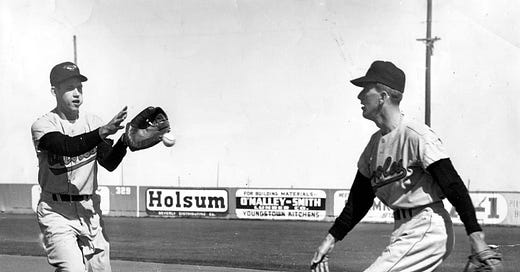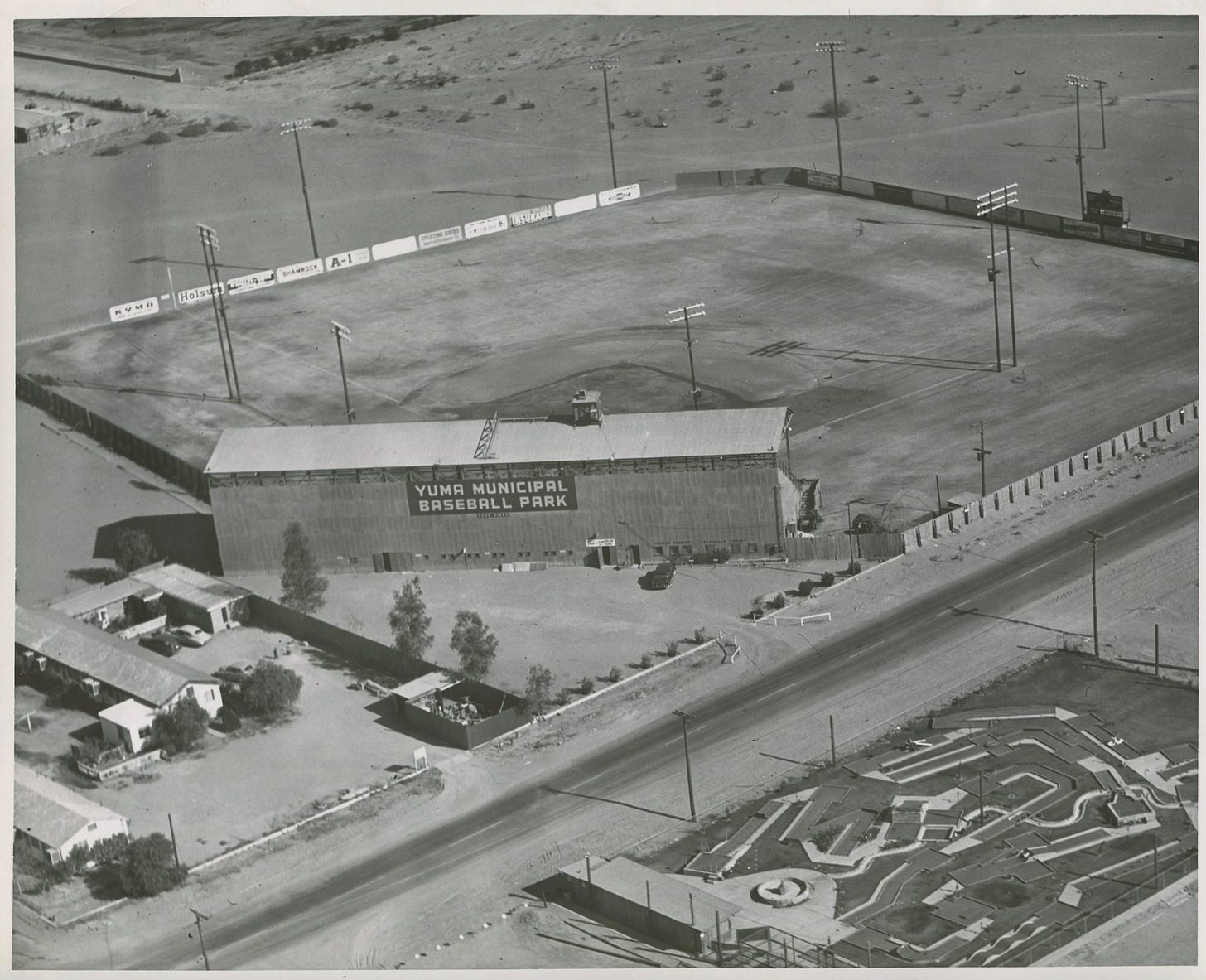There Were Birds in Yuma
As the Orioles' 2025 spring training camp opens in Sarasota, it's startling to look back at what they endured 71 years ago in their inaugural spring season, which took place a long way from Baltimore.

The Orioles had no say in the location of their inaugural spring training camp. Before Bill Veeck sold the St. Louis Browns to a group of Baltimore businessmen who brought the club to Maryland in 1954, he signed a deal to hold spring training that year in Yuma, Arizona. The contract remained binding despite the sale of the team.
As improbable as it sounds now, the Orioles took their first steps a long, long way from Baltimore, overlooking the Colorado River in Southwest Arizona.
Yup, Yuma.
“There wasn't much there except a drive-through marriage bureau. You could get married without leaving your car. People from California would drive over to do it. Otherwise, (Yuma) was small and isolated,” said Ernie Harwell, the Orioles’ first play-by-play broadcaster, in his Bird Tapes interview.
Only three other major league clubs were based in Arizona that spring — the Giants in Phoenix, the Cubs in Mesa and the Indians in Tucson. A drive of at least three hours separated the Orioles from all of them. Veeck had planned to fly the players to and from road games, but the Orioles’ new owners nixed the idea as too expensive.
Years later, when I interviewed Harwell and players from the 1954 team for my book on Orioles history, pretty much all they remembered about that spring training were the hours and hours spent on buses.
“It was a long trip back and forth every day,” Harwell said. “We’d stop in Gila Bend for a hamburger and a beer and move on.”
Billy Hunter, the shortstop on the team, said in his Bird Tapes interview, “We’d have a team going out (from Yuma) on a bus and a team coming back on a bus, and we’d meet at Gila Bend. Players transferred from one bus to the other, depending on our needs for the day. Sometimes we spent the night in Phoenix, sometimes not. We spent hours and hours and hours on buses.”
The city of Yuma did its best to make the Orioles feel welcomed. A banner was strung across the main street in town. Comedian Joe E. Brown was brought in to host a banquet. A volunteer group helping the sheriff’s office fed the players a “chuck wagon breakfast” consisting of steak and eggs.
The players stayed at the Flamingo Hotel, which was more of a motel but did have a pool, restaurant and rooms “cooled by refrigeration,” according to the sign out front.
The Orioles practiced and played their home games at sun-baked Municipal Stadium, which housed a team in the Class C Arizona-Mexico League during the season and also hosted local high school games. A putt-putt course was across the street.
Cactus League games between major league clubs were such an occasion in Yuma that schools let out early so kids could attend. But unfortunately for the kids, the Orioles only played four games in Yuma, drawing an average attendance of 2,671, and spent the rest of the spring on the road, dodging sandstorms on desert highways.
A contingent of Baltimore media covered the camp, reporting back to a city that was delighted about having a major league team again after a half-century in the minors. The Orioles stoked enthusiasm with their performance in the Cactus League. Coming off a 100-loss season as the Browns in 1953, Baltimore opened with five straight wins and wound up winning 12 of 17 games in Arizona, knocking six home runs in one of the wins. The record earned them the Cactus League title and the 27-inch trophy that came with it. Encouraged, Orioles manager Jimmy Dykes suggested his club would surprise the league in 1954. (It didn’t, losing 100 games and costing Dykes his job.)
The Orioles broke camp in Yuma three weeks before the regular season opened, and instead of flying back east, they boarded a train and barnstormed in that direction, playing exhibition games against the Cubs every day for several weeks. Harwell recalled:
“That was a long haul, really tiring. You needed spring training again after the trip ended. We’d play a day game in, say, Alpine, Texas, or El Paso or somewhere, and after the game, we get back on the train at four or five o’clock and have dinner and then there would be some card playing, and then you went to bed. When you got up the next day, sometimes you could go to a hotel and then have a room where you could wash up and change and then go to the park. Sometimes you went straight to the park. The Cubs fired their manager on the trip. We were in Dallas.
“The way it worked, each team had a couple of Pullman cars and its own dining car. There was a lot of camaraderie between the teams. They had friends on the other team. I don’t think we spent a night in a hotel for 10 days or two weeks. I remember we stopped in New Orleans, and we had about 55 guys on the squad at that point, and they sent one team out to play in Mississippi and another to Alabama. They all bused back to New Orleans at night. It was a mess. We stayed in the Roosevelt Hotel for a week. That was fun. That’s where the gin fizz was invented and there was an orchestra. We had a good time eating that New Orleans food. We finished up with a couple of exhibition games in St. Louis, where the team had just come from, which was strange. Then we went to Detroit.”
The Orioles opened their inaugural season with a 3-0 loss to the Tigers at Briggs Stadium in Detroit on April 13, 1954. A year later, they held spring training in Daytona Beach, Florida, which was a lot closer to home.
They never went back to Yuma.






I love this article John. I grew up in NEPA and became an O's fan as a 10 year old in '65. I moved to Phoenix in '78. I have seen the Cactus League grow from 6 to 15 teams and the stadiums become so state of the art and beautiful. The picture of the Yuma (stadium) made me laugh. Thanks again for sharing. Let's Go O's!
WOW! Things are sure different today-in every possible way.